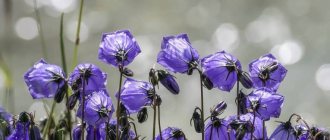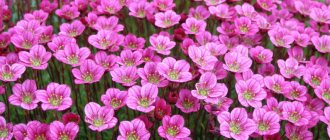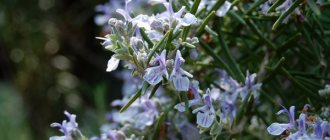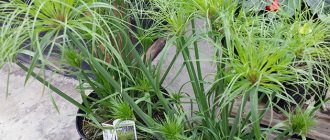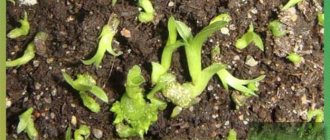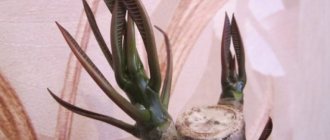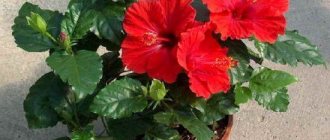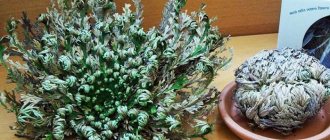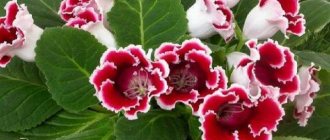Cyperus is a herbaceous evergreen plant from the sedge family. It has many other names. It is often called Sytya, Papyrus, Sitovnik, Sedge alternate-leaved and even Venus grass. In the UK it is called the "umbrella plant" because its leaves resemble an open umbrella. With its spectacular appearance, Cyperus decorates many corners of homes and offices, clinics and kindergartens, workshops of industrial enterprises and shop windows. With the help of Cyperus, you can organize green thickets on your balcony or terrace, swaying in the wind. In addition, Cyperus is a very useful flower. It perfectly moisturizes dry air and is a natural “vacuum cleaner”. Next, we will talk in detail about caring for Cyperus at home, and also describe all the methods of propagating this flower.
Habitat
The island of Madagascar and the tropical forests of Africa are considered the homeland of Cyperus. For its love of ponds and constantly moist soil, in Egyptian folklore the flower was called “gift of the river.” This plant is found both in America and in Eurasia along the banks of rivers, lakes and swamps in close proximity to water and in water, where it forms impenetrable thickets. Cyperus was brought to Europe in the 18th century, and it began to be grown indoors in the 80s of the last century. Sitovnik quickly gained popularity due to its unique elegant appearance (looks like a dill umbrella or a small grassy palm) and ease of care.
In our country, such relatives of Cyperus are known as Kamysh, Sedge and Sitnyag.
Description
The ancestor of the plant can be considered the ancient papyrus growing along the banks of the Egyptian Nile. Nowadays, cyperus (another name for Cyperus) is less common, it can only be found in the river delta, and species that were previously widespread in other places, for example, Ecuador, have completely disappeared from the face of the Earth. Looking at the graceful umbrella plant, it is difficult to imagine that its predecessor once rustled three-meter thickets and served as food for hippopotamuses.
Of course, the role of plants of this genus (and the genus belongs to the Sedge family) was not limited to this. Shoes and clothing (fabrics) were made from papyrus; even ships were built from thick trunks of paper ships.
They used it for food; types of edible food (ground almonds) were grown for their sweet tubers. The doctors used this wonderful plant and made infusions to treat colds and stomach pain.
Classification - sedge (Cyperus, hence the name - cyperus) belongs to the genus of perennial herbaceous plants (sedge also belongs to this family). It is interesting that in our country you can meet representatives of the Osokovs, for example, in the Far East. This is not surprising, because there are already more than seven hundred representatives of Cyperus: along the floodplains of reservoirs, along swampy shores, wherever there is a lot of moisture and relatively warm.
Externally, all representatives are similar. These are rhizomatous plants that form several stems that originate close to the ground (from the root). Each stem ends in a rosette of narrow leaves of a very beautiful green hue. It blooms simply - small flowers of dim color form modest umbrellas.
Description of the plant
In the wild, some species of Cyperus grow up to five meters, forming dense, impenetrable thickets (at home they are much more modest - from 50 to 100 cm.) The root of Papyrus is located on the surface of the soil. It is long and creeping. Sometimes, instead of a root, spindle-shaped processes grow, which perform the function of a root and extract nutrients from the soil. The type of root depends on the species diversity, this should be taken into account when selecting suitable soil for the plant. Cyperus species with short roots are suitable for indoor cultivation in a pot or flowerpot.
Papyrus has long, bright green, flowering stems. Over time, they age, become yellowish and die. Such stems should be cut off in time so that new ones begin to appear in their place. The tops of the stems end in rosettes of whorled thin leaves.
Linear leaves open in the form of umbrellas. They vary in length and are unevenly distributed. The result is a kind of sun rays that give the flower volume.
The color of the plant is heterogeneous. It ranges from dark green to light green. The leaves are even two-colored. Sometimes there are white and brown strokes.
Botanical description
Cyperus in natural conditions grows up to three meters in height. Its stems are erect, triangular, at their top there are umbrella-shaped whorls of long leaves of different shades of green, although there are variegated varieties in cultivation. Small flowers are unattractive; they hide in the axils of the leaves. Homemade cyperus is an unpretentious, shade-tolerant plant; it is grown to decorate shaded areas of the room or small artificial reservoirs.
Bloom
Cyperus is a flowering plant. Peduncles are triangular in shape. They are erect, but flexible, so they do not break under the pressure of the wind. Small, inconspicuous flowers of Cyperus are arranged singly or in a rosette. They are pale green, light brown or milky in color. Most often, flowering is observed in the summer, in June or July, but some varieties bloom throughout the summer until mid-autumn. After flowering, small fruits appear - nuts or spikelets of a brownish color. Pollination occurs due to wind - fine pollen is quickly carried by the wind to nearby plants.
Features of Cyperus
Cyperus is a perennial with herbaceous shoots, they have nodes in the upper part that are located quite close to each other. The leaf blades grow from close nodes, with this shape they are somewhat similar to umbrellas. Only a few species are grown indoors. This moisture-loving plant grows very well in the shade. Cyperus is often used to decorate aquariums, and they are also placed in places where it is very dark for other crops. Most often it is grown in semi-indoor areas in not very large artificial reservoirs.
Signs and superstitions
It is believed that Cyperus species with multi-level stems and umbrellas of leaves, similar to a waterfall, attract positive energy into the house, which keeps the owner and his family active and cheerful, and helps them overcome difficult problems. We recommend that those who have schoolchildren, students and scientists in their families get this flower. The energy of the flower will help them cope with educational and mental stress, and humidifying dry air and increasing the release of oxygen will make the brain more active.
Cyperus - a medicinal plant
There are flowers that you absolutely must have in your home. They affect energy metabolism, thereby improving our well-being. Cyperus is just such a plant. It gets rid of bad thoughts and negative emotions, decorates the house and brings only good energy.
People suffering from insomnia are recommended to place a flower in the bedroom. It will help you relax and fall asleep peacefully, purify the air in your child’s room and promote his learning. It will relieve irritability and increase the level of perception of new educational material.
There is no need to be afraid of far-fetched signs and superstitions surrounding this flower. People have been using it in their lives for thousands of years, and this only speaks of its positive impact on us.
You can buy the plant at any flower shop, you can also buy seeds. Propagation by seeds will take longer, but will be cheaper, and the number of seedlings will be greater.
Benefits and Applications
Cyperus Helfera in an aquarium
These moisture-loving plants are widely used to decorate aquariums, artificial waterfalls, and winter water gardens. In home spaces, it can decorate any green corner and give it a tropical look. Since Cyperus grows almost in water, it evaporates a lot of moisture, saturating the surrounding air with it, which has a beneficial effect on the plants adjacent to it and, in general, on the microclimate in the room.
It is interesting that from the stems of Cyperus Papyrus in Ancient Egypt they built papyrus boats, wove baskets and mats, made ropes and wove sandals. Papyrus was made by pressing the stems of the plant together. The first paper was also made from papyrus. Many ancient monoliths preserved parts of papyrus books. Now the Cyperus plant is listed in the Red Book as an endangered species.
The rhizome of the plant in South Africa is used as food - added to first and second courses, in salads, and in drinks.
Cyperus is also a medicinal plant. Decoctions from the leaves and stems of a living plant help with headaches and insomnia. Drinking on an empty stomach, this drink normalizes blood pressure and accelerates metabolic processes in the body. With its help you can restore your vision. The taste of the decoction is herbaceous, but without bitterness and with a pleasant aroma. If you add honey to it, the drink can treat stomach pain.
Cyperus leaves are to the taste of cats and parrots. They simply have an irresistible craving for this flower. By the way, it is not poisonous and does not harm pets. But they are very big for him. If you don’t keep track, the flower will be gnawed beyond recognition.
Due to its creeping and rapid growth, the flower is considered a weed in its homeland. When growing cultivated plants, it is weeded out like a weed.
Useful properties of Cyperus
Cyperus not only has an original decorative appearance, but is also widely used in the treatment of certain diseases. A decoction of its leaves is used as a remedy for headaches and stomach pain, high blood pressure, and insomnia. In some countries, the roots of the plant are added to food and drinks. The stems are used as material for weaving boxes and interior items.
Types and varieties
Cyperus is a large genus of about 600 plant species found throughout the world. But, only some of them are used in indoor floriculture. We will introduce you to the most popular indoor specimens of Cyperus.
Papyrus
Cyperus papyrus L.
Papyrus is common in the swamps of Egypt and Ethiopia. Reaches a height of three meters. The erect and strong stem of the flower ends in a dense whorl of long hanging leaves, from the axils of which multi-flowered inflorescences appear on thin stalks. In cultivation, due to its large size, it is grown in tubs and mainly in greenhouses.
Helfera
Cyperus Helfera
Cyperus Helfera has low stems, up to 0.5 m in height. It grows in water, so it is often grown in aquariums and paludariums (a transparent tank with an artificially created semi-aquatic habitat for keeping aquatic plants, including marsh and coastal plants). Outdoors it is used for landscaping decorative ponds. Loves a slightly acidic substrate with a pH of 5–6.5.
This may be interesting: Fatsia Japonica (Aralia) - what you need to know about the guest from the east
Zumula
Cyperus Zumula
This species is a bit similar to Cyperus helfera - the same tuft of grass blades growing straight from the damp ground and some palm-shaped leaves. But it grows in a pot. A very spectacular flower. Propagates well from seeds purchased in the store. But dangerous for pets.
Umbelliferous (Alternate-leaved)
Cyperus Umbrella or Alternate-leaved (C. alternifolius L.).
This is the most common type in indoor growing. It grows in nature on the island of Madagascar along the banks of swampy rivers and lakes. It grows up to 1.7 m in height. The stem is triangular, erect, with an umbrella crown of leaves at the top. The leaves are narrow, linear, drooping, resembling belts. Their length is about 25-30 cm. Flowers appear in the axils of the leaves, collected in small panicles. Easily propagated by dividing the bush, umbrellas and seeds.
There are garden varieties of Cyperus Umbrella:
Gracilis
Cyperus "Gracilis" is distinguished by its compactness and narrower leaves.
Cyperus "Variegatus" - has leaves and stems that are white or mottled with white stripes.
Spreading
Spreading Cyperus (C. diffusus Vahl.) is a smaller copy of the swamp palm. This species is the lowest of the Cyperus. Height is from 40 to 90 cm. The stems are few in number, but the plant has numerous basal long and wide leaves, due to which the bush looks lush. In the upper part the leaves are narrower, collected in umbrellas of 6-12 pieces. The flower is unpretentious in care, but requires constant high air humidity.
Types of Cyperus domestica with photos and names
The following flower varieties are most popular for keeping indoors:
Cyperus alternate leaf
Also known as common leaf plant - a plant about a meter high with long umbrella-shaped leaves and white-green flowers. It is widespread as a decorative foliage decoration not only for interiors, but also for landscapes. It feels ideal near ponds and reservoirs, when the lower part of the stems is located in the water and the upper part is above the surface.
Cyperus stunted
Its second name is thin, white-striped or graceful cyperus. It is distinguished by its compact size - the stems do not exceed a length of 30 cm. The leaves often have a wide white stripe and hang down to the stem in a lush “panicle”.
Cyperus umbelliferum
The tallest of the indoor representatives of the plant - the height of the bush reaches 1.7 meters. It is characterized by a rounded leaf shape, a dense crown with yellowish flowers.
Caring for a plant at home
Growing Cyperus indoors is not difficult, and you can learn how to do it correctly. There would be a desire. We will help you with this.
Location and lighting
Cyperus does not like a lot of light. He prefers shady rooms, next to an artificial pond or aquarium. Then he will fill the room with freshness and cleanse it of dust. But it will not actively grow and bloom in complete darkness, but somewhere close to direct sunlight. If possible, take Cyperus outdoors for the summer. In winter it will decorate your home, and in summer it can decorate your garden. If it has a pond, even better. Near him, Cyperus will be in his usual environment. In this case, the flower pot can be placed directly in the water or buried in the ground not far from it.
In winter, the flower will lack natural light due to the short daylight hours, and you will have to provide additional, artificial lighting for it using a phytolamp or fluorescent lamp for up to 14 hours a day.
Spacious eastern or western window sills are well suited for flowers. On the south side of the apartment, the pot is placed away from the window so that the light is bright but diffused.
Cyperus loves fresh air and is not afraid of drafts. Ventilate the room, then you will see how its thin stems with thread-like umbrella leaves begin to move from the slightest breeze (an open vent, window, fan, air conditioner), captivating the eye with its unique lightness and unusual appearance.
Air temperature
A comfortable temperature for Cyperus in the summer is considered to be the usual room temperature of 20 - 25 degrees. If the thermometer creeps higher, ventilate the room more often, spray the flower and the air in the room. A good solution would be to take the flower pot out into the fresh air, otherwise the heat may negatively affect the appearance of the flower.
In winter, in the wild, Cyperuses tolerate a short-term drop in temperature to zero degrees, but at home it is better not to lower the temperature below 14 degrees. Keep this in mind when ventilating your room in winter. It is better to remove the pot away from drafts and do not leave windows and vents open for a long time.
Air humidity
Cyperus is quite demanding in high humidity not only of the soil, but also of the surrounding air. Humidity of 65 - 75% is considered normal for it. But many indoor flowers will not like such humidity, so carefully select neighbors on the windowsill for papyrus.
You can maintain high air humidity using a household humidifier, if you have one, or using a spray bottle, which should be sprayed regularly over the entire plant. Loves flowers and bathing in the shower. Water treatments wash away dust from the leaves and stems, and the plant immediately comes to life after them. All kinds of water vessels and aquariums also help maintain high humidity levels. In winter, when heating devices are operating in the rooms, place the flower pot away from them and spray them regularly. You will understand that the flower lacks moisture by its leaves, the tips of which will begin to dry out and turn black.
Watering
Cyperus is a very moisture-loving plant due to the fact that in nature it grows in swamps and along river banks. With a lack of watering, the leaves immediately turn yellow and dry out. To keep the soil in the pot moist, the flower should be watered every day. There is no need to be afraid that the root system may rot from waterlogging - the soil should always be moist. It’s the same in nature - tropical downpours moisten the soil, and the scorching sun evaporates excess moisture.
Root rot can occur if the room temperature is extremely low. Then, until you adjust the temperature, drain the excess water from the pan.
A constant level of soil moisture can be maintained using bottom watering through a tray, from where the plant’s root system will take the required amount of water. It’s even better if the pan is so deep that the water level in it reaches the middle of the pot.
Now many people are interested in how to water cyperus in winter. In winter, when the room temperature drops, the flower will drink less. Watering should be reduced and removed from the tray with water, but still make sure that the soil in the pot does not dry out.
For irrigation, use settled tap water at room temperature, but it is even better if you stock up on rain or melt water.
If you need to leave home for several days and you are afraid of drying out the flower, we recommend that you place the pot in a deep basin or bucket of water
Another trick will help the flower last a long time without regular watering. Add a little soaked hydrogel to the soil. It is made from polymers specifically to retain moisture. Several grains of hydrogel absorb up to 100 ml of water and swell. The roots of Cyperus, penetrating the gel, receive moisture from there. If you saturate the hydrogel with mineral fertilizers in a small dose, then you will not only have to water, but also feed the flower less often.
This may be interesting: Tradescantia - home care
Sowweed thrives when grown hydroponically. Sometimes pure hydrogel is used for this. And some species of Cyperus (for example, Helfera) are simply grown in indoor aquariums.
Top dressing
Cyperus responds gratefully to feeding during the entire growing season - from early spring to autumn. Complex fertilizers should include nitrogen, potassium and phosphorus minerals. It is better to buy liquid fertilizers for decorative deciduous indoor flowers in special stores. Feed Cyperus two to three times a month. In winter, if the flower stands in bright light and continues to produce its umbrellas, do not stop fertilizing, only do it once a month and reduce the single dose by half, since an excess of fertilizers for the plant is just as harmful as a deficiency.
Fertilizer application rules:
- follow the manufacturer’s dosage, as the formulations can be simple or concentrated;
- for young bushes, reduce the dose by half;
- Before adding the solution, water the soil well so as not to burn the roots;
- to avoid burns, make sure that the solution does not get on the greens;
- In spring, feed the flower with nitrogen-dominated fertilizers. They will accelerate the formation of green mass. Then apply fertilizers with potassium and phosphorus for the formation of inflorescences and lush flowering.
Planting and caring for tsiperus
- Flowering: grown as an ornamental foliage plant.
- Lighting: bright diffused light, partial shade (eastern or western window sill).
- Temperature: in summer – normal for residential premises, in winter – not lower than 12 ˚C.
- Watering: frequent and plentiful.
- Humidity: very high. It is recommended to constantly spray the leaves and keep the plant on a tray with wet pebbles.
- Feeding: complex fertilizer for decorative deciduous plants: in the warm season - twice a month, in winter - once.
- Rest period: not observed.
- Replanting: as needed at any time of the year.
- Reproduction: by seeds, dividing the bush, apical cuttings and rosettes.
- Pests: spider mites, aphids.
- Diseases: does not get sick, but due to insufficient humidity it may turn yellow and lose its decorative effect.
Read more about growing Cyperus below.
Transfer
Cyperus tolerates transplantation well, without compromising its growth, so it can be done at any time of the year. For example, an adult plant is replanted if the soil is completely depleted or when the pot has become too cramped. However, if you want the flower to become a real decoration of your home and not lose its decorative value for many years, do not allow extreme cases and replant the plant every year.
We recommend that you replant Cyperus in early spring or late autumn, during periods when plant growth stops. Before transplanting, try to ensure stable temperature and humidity, then the flower will avoid stress.
Remove the plant from the pot and lightly shake off the old soil. If you see damaged roots, cut them off with a sharp, clean knife. Dust the cuts with crushed charcoal. If it is possible to rid the rhizome of all the old soil, do it. Then place the bush in a new pot of suitable size - not too spacious and wide. Fill in the new soil carefully, without damaging the roots.
Young bushes are transplanted annually into slightly larger flowerpots.
Pot
Cyperus has rather long, vine-like roots, so a deep pot is suitable for it. If you have a powerful plant that quickly produces new shoots, then the width of the pot should be such that the root system of the flower not only fits there, but also develops well.
Pebbles or expanded clay with sand 3–4 cm high are placed on the bottom with drainage holes. Pieces of charcoal, brick chips and crushed eggshells can be added to the drainage.
Priming
Growing in swamps and river banks, Cyperus does not have any special requirements for the composition and nutritional value of the soil. A mixture of peat, turf and humus soil, sand in equal quantities with the addition of dry grass and, preferably, swamp or river silt to ensure good moisture and breathability would be suitable for it. Then the water will bubble around the root system.
You can pick up ready-made soil in the store, suitable for moisture-loving indoor plants, with a pH from 5 to 8.5. Sawdust or dried tea leaves are usually poured on top of the soil for good air exchange. However, if you use immersion of a flower pot in water when watering, it is better to sprinkle a small layer of river sand on top. This will prevent the soil from being washed away.
Features of the plant
The genus Cyperus or Syt belongs to the botanical family Cyperaceae (Sedges). The name comes from the Greek word "kyperon", meaning "aquatic, meadow plant". One type of sedge is known as "papyrus sedge" and "paper reed". In nature, plants of the genus Cyperus form continuous green walls in swampy areas and on the banks of reservoirs.
Botanical description:
- Cyperus are perennial herbaceous plants reaching a height of 1–5 m.
- Low varieties are common in indoor floriculture.
- Individual shoots resemble umbrellas or palm trees.
- The long, thin leaves are colored in various shades of green.
- The flowers are inconspicuous, pale green or light brown, collected in groups among the apical leaves, pollinated by the wind.
- The seeds are small nuts.
The homeland of many species of the genus Cyperus is the tropics and subtropics of Africa, Madagascar, and China. The characteristic appearance and love for wet places are the reasons for the appearance of the names “swamp” or “water palm”, “swamp”. Cyperus has interesting roots that have large intercellular spaces filled with air. They are light, do not sink, and partially float in water.
From a floriculture point of view, Cyperus is a decorative foliage crop. In the skillful hands of flower growers, the plant becomes part of beautiful compositions, where it plays the main role.
The intensity of leaf color depends on the type and variety, and conditions of detention. The photo of Cyperus shows that some varieties are light green, others are bright or dark green. The leaves of varieties whose name contains the word “variegate” are white-green.
Cyperus are used to decorate windows; they are grown in aquariums, winter gardens and greenhouses. In summer they are placed in the garden next to a spring, fountain or pool. Plants thrive in hydroponic culture, forming powerful clumps.
Reproduction of Cyperus
There are many ways to propagate Cyperus: by dividing the bush, tubers, cuttings, rosettes and using seeds. The choice depends on the growing conditions, your desire, and the ability to purchase seed material or shoots. We will consider all methods of reproduction in order.
Dividing the bush
During the next transplant of a bush that is at least two years old, it can be divided into parts. Each part must have at least three shoots. Use a sharp, preferably disinfected knife. Treat the cut areas with ash or crushed charcoal (activated) charcoal. Try not to let the earthen ball crumble too much.
The resulting bushes should be immediately planted in prepared pots using suitable soil. In the future, provide them with watering and other favorable conditions. There is no need to feed in the first month.
Reproduction using tubers
Rhizomatous tubers can also be divided during the next transplantation of an adult Cyperus and each part can be used to obtain new plants. To do this, simply dig them into separate pots.
Propagation by cuttings
When cutting the stems in spring, you can get excellent cuttings for producing new Cyperus bushes. To do this, cut off the top of the stem under the last whorl node. Cut the leaves to two-thirds of the length. Place the cuttings obtained in this way in a container with sand, leaves down. Place the container in a warm, well-lit place with diffused light. Water thoroughly. Even if the cuttings dry out over time, young shoots will probably appear from the soil. This means there are roots too. After a month, transplant the bush into a new small pot.
You can also root the cuttings in water. Just immerse it in a container of water with the leaves facing down. When sufficiently strong roots appear, the cuttings can be transplanted into the substrate.
When the new plant begins to grow, transplant it into nutrient soil. Select the pot according to size.
Leaf rosettes
When Cyperus grows strongly, you will see that another rosette has formed in the center of the leaf rosette. This rosette can be plucked off so as to grab a part (5 - 8 cm) of the stem, and placed upside down in a container with warm (about 24 degrees) sand to take root. The middle of the socket should be pressed against the sand with something. Over time, roots will appear at the point of contact. Be sure to water, the sand should always be wet. The roots will appear soon. Wait a little until they get stronger and transplant the shoot into the prepared substrate.
Sometimes the socket is not pinched off, but is done as follows. Deflect the selected stem with a rosette towards the soil, secure it at the growing point and cover it with moist soil. Separate the seedling from the mother plant after roots appear.
In the wild, the stems of Cyperus, bent by the wind towards the water, take root there. The stem of the mother plant dies over time, and the new young plant takes root and begins to live its own life. This method of reproduction is also applicable at home. The leafy apical rosette, without being separated from the mother bush, is tilted towards the water and germinated there. Roots appear quickly. After they grow a little, separate the rosette and transplant it into a prepared pot.
Growing from seeds
This is the most labor-intensive but effective way to propagate Cyperus. First treat seeds purchased or received as a gift with a weak solution of manganese. Dry. Prepare a container with a lid, fill it with a mixture of sand and peat, and moisten it. Place the seeds on the surface of the substrate without deepening them. Close the lid. Maintain a constant temperature in the greenhouse of at least 20 degrees. and high humidity. If necessary, ventilate and moisten with a fine spray bottle of warm water.
This may be interesting: Formation of the appearance of Ficus Benjamin
Choose a place for the container that is well lit, but not in the sun. If daylight is still short, turn on a fluorescent lamp in the evening to extend it. Wait until four to five true leaves appear, and only then start transplanting the seedlings into separate pots. Often such sprouts are planted in groups of 3. in one pot to make the bush more lush.
Cyperus in the aquarium
Cyperus Helfera makes a great addition to underwater aquarium gardens. The long ribbon-shaped leaves are located partially under water, but some part of the leaf blade rises to the surface and spreads along the water surface, which looks very beautiful. It is especially pleasant to watch when the leaves sway slightly along the artificially created flow.
Of course, for Cyperus to grow luxuriantly in water, favorable conditions are necessary. This includes temperature (not lower than +22°C) and acidity closer to neutral. Also, satiety responds well to carbon dioxide fertilizing.
A guest from distant warm countries - Tsiperus - is good for everyone. And unpretentiousness, and excellent health, and the decorativeness of lush, openwork bushes, and grateful responsiveness to care. This makes it stand out among many indoor plants and makes it a favorite among both beginners and experienced gardeners. And soon, a wonderful plant - cyperus will become not a guest, but the owner of home flower beds.
Diseases and other problems
Cyperus has a fairly strong immune system; the flower is resistant to various diseases and pests. Problems arise only when there are gross violations of the rules of care. Let's look at possible problems and ways to fix them.
The leaves became smaller and the color became lighter.
The plant does not have enough lighting. If this happens in winter, arrange lighting. To do this, use fluorescent, fluorescent and phyto lamps, but not heating lamps. If in the summer, find a place for the flower that is more illuminated by bright light, so that there is at least 12 hours of daylight.
Cyperus leaves turn yellow.
There may be several reasons:
- If the flower does not have enough moisture and the air in the room is too dry, which literally burns the delicate leaves and tops of the flower, they will turn yellow or even brown. Adjust watering, let it be more frequent and abundant. Install additional humidifiers in the room. Place the flower away from heat sources. Place the pot in a pan of water so that the pot is half immersed in water - let the plant be saturated with moisture.
- The nutritional value of the soil has been depleted. You haven’t transplanted the plant into a new substrate for a long time, you forgot about regular fertilizing during the growing season - so the soil has become unusable. Feed your pet or replant the flower in new soil.
- The pot is too small. The roots completely filled its space in the pot, the plant became cramped. It is necessary to transplant Cyperus into a larger pot and replace the soil.
The bush or its individual parts, leaves, stems and inflorescences, began to fade.
The reason may be high ambient temperatures. It is necessary to regularly ventilate the room, monitor temperature and humidity readings. In the summer, take the plant out into the fresh air, closer to a pond, or at least onto a terrace, balcony, loggia, where a fresh breeze blows.
Cyperus has stopped growing or the rate of its development has slowed down.
The reason, again, is the lack of nutrients in the soil and the pot being too small for the flower. Most likely, it's time to change them. After changing the pot and replacing the soil in it, active growth of the plant will resume and it will have the opportunity to flower.
The leaves of the flower are covered with gray spots.
It's similar to sunburn. If your flower is on the south side of the apartment in direct sunlight, then this is so. Place the pot further into the room, where the lighting is bright but slightly diffused. If this is not possible, cover the window with a light curtain or blinds.
Cyperus leaves have become soft and brown.
This happens under unfavorable growing conditions: low room temperature, musty water in trays, dry air and direct sunlight. Analyze and correct your situation. Compliance with the rules of Cyperus agricultural technology will allow you to avoid such incidents in the future.
The tips of the leaves dried out and turned brown.
Most likely, the air in the room is too dry. Spray the flower and the space around it twice a day, place the pot in a pan of water, turn on the humidifiers, and in winter, cover the heating radiators with wet towels. Do everything to increase the humidity in the room.
The stems turned yellow in winter and the leaves began to die.
It's too cold here. Cyperus does not withstand temperatures below 15 degrees. Move the pot to a warmer room. Remove damaged leaves and stems.
Massive drying of leaves.
This happens when the earthen clod dries out. You are not watering your moisture-loving flower well. Trim off any dead stems and leaves. Immerse the pot in a basin of water (settled, at room temperature, you can add growth stimulants Epin or Zircon there).
In an adult plant, old leaves began to turn yellow and dry out.
This is a normal process characteristic of many plants. Cut off the yellow stems at the root and wait for young shoots to appear.
The roots are rotting.
This is possible at low temperatures (15 - 16 degrees), when the flower is also standing in a tray with cold water. Move Cyperus to a warmer place. Drain the water from the pan. Remove the bush from the pot and inspect the roots. If they are brown and soft, the flower cannot be saved. If there are light roots, remove the black and damaged ones and treat the sections with crushed coal or ash. Plant the flower in a new container with fresh substrate. Water the plant with water with the addition of the fungicide Fitosporin. We hope that the flower will recover from its illness, and in future, do not violate the rules for keeping it at home.
Pests
Cyperus has well-developed protective functions, moreover, it grows almost in water, it is constantly sprayed, washed, washing off not only dust, but also uninvited guests from its leaves. But, like any indoor plant, if the rules of their maintenance are violated, Cyperus can be attacked by insect pests such as thrips, spider mites, whiteflies, scale insects, mealybugs, and aphids.
The presence of parasites can be determined by the following signs:
- punctures on leaves;
- cotton balls on stems and other parts of the plant;
- yellowish tint of the leaf plate, its deformation;
- the presence of cobwebs in the internodes and on the back of the umbrellas;
- white dots on the inside of the leaf;
- brown tubercles on the leaf surface;
- flying midges;
- sweetish-sticky coating on the stem and leaves.
Inspect your plant. If you find something like this, urgent sanitation is necessary. In the bathroom, wash off all parasites from the plant in the shower, if possible. If the damage is severe, treat the flower with some insecticide after bathing. The store will offer you a choice of them for every taste. Spray or water, once or several times, until the pests are completely destroyed - as the manufacturer advises. If trouble happens in the warm season, it is better to carry out the treatment outdoors - on the veranda or on the street, so as not to poison the air in your home.
Possible problems
Why does Cyperus turn yellow?
Very often this problem is associated with a lack of mineral nutrition. This happens when the plant suffers from a cramped pot or salty or acidic soil. It is necessary to transplant the cyperus into a free container, renewing the soil, and then feed it with mineral fertilizers.
Why do the tips of Cyperus leaves dry out?
Also a common problem. The fact is that satiety is very moisture-loving. Any disruptions in the drinking regime lead to drying out of the tissues and general oppression of the plant. It is necessary to stabilize watering by spraying the flower, and also to increase the air humidity in the apartment.
If the owner organizes a summer vacation for the pet somewhere in a summer garden near a pond, the tsiperus will be especially grateful.
Reproduction
Cyperus alternate-leaved readily reproduces in almost any conditions. The procedure is not difficult and even a novice gardener can do it. Under natural conditions, to reproduce, Cyperus tilts the rosette towards the water and takes root there. As a result, the mother plant gives new life. You can repeat this experience. That is, lower the rosette into a vessel with water and secure it, but do not separate it from the plant yet. Then you can plant the plant in a separate pot.
The second method is even more convenient. Cyperus plants older than two years are suitable for this method. You don’t even have to remove the bush from the pot. Carefully divide the lump with a knife to the very bottom and carefully remove half or a quarter of it. The rest can be carefully straightened and filled with fresh soil. Also plant the second half in another pot. You can divide it into more parts. The main thing is that each of them consists of three or more shoots. A large bush can be planted into a dozen pots. Each of them will soon turn into a large, beautiful bush. Moreover, this will require very little time. This plant has a high growth rate.
Pest and disease control
Cyperus hardly gets sick and does not even suffer from fungus in high humidity. Almost all problems with leaves are associated with excessive dry air or improper light conditions. In winter, the leaves fade from lack of sun or due to the proximity of heating devices.
Photo: gardensite.co.uk
Date palm (50 photos): types, care and cultivation at home
Main problems
Sometimes even with this unpretentious plant, people have difficulty caring for it. Cyperus alternate leaf can present the following surprises:
- The leaves turn yellow and dry out. This most often indicates that the air around the plant is dry. The plant needs to be watered, placed in a tray with water and sprayed well.
- Leaves die. This means that the cyperus is cold. The tropical guest does not like lower temperatures. Move it to a warmer place and it will recover on its own.
- Leaves wither and growth slows down. Your plant is not getting enough light. Cyperus tolerates a lack of light well, but it is still needed for photosynthesis.
Getting to know Cyperus
Oddly enough, but it connected: two in one. This is marsh grass and, at the same time, a magnificent decoration for many homes. Looks great among other household inhabitants and next to an aquarium, as well as in a garden near a pond.
The long stems are framed by umbrella-shaped rosettes of thin leaves, and the triangular, flexible peduncles are stable and do not break even in strong winds. The plant looks voluminous thanks to the diverging rays.
The palette is multifaceted - from light shades to rich green tones. In some places, whitish leaves are visible. Among the foliage, small milky flowers are almost invisible.
In the first summer months you can see how the cyperus blooms, and the flowering of certain varieties lasts all summer. The seeds are small pollen, carried even by a light breeze.
The roots of the plant are long and creeping, but there are also short ones. It is the flower with small roots that is suitable for growing at home.
By the way, cyperus is not the only name of the flower. This includes sedge, sedge, venus grass, and papyrus. While reading Egyptian folklore, you are sure to come across a flower with a beautiful name - the gift of the river. This is also a cyperus.
Cyperus and cats
One of the difficulties that pet breeders who own Cyperus constantly face is the feline’s tender love for the plant. The cat ate cyperus, what to do - this is a question often asked on gardening forums.
Cyperus is a relative of the cat's favorite grass, sedge, and belongs to the Sedge family, which means it is ideal for furry pets. With the help of herbaceous plants, pets clean their stomachs. Therefore, there is no need to worry, eating cyperus will not harm the cat at all, and on the contrary, it will be beneficial.
However, on the other hand, such excessive love can have a bad effect on the plant. Damaged leaves and nibbled stems are a trauma for the flower, and they look very ugly. How to protect Cyperus from a cat? Here are some easy ways:
- Place the flower in a place where your pet cannot reach.
- Buy cat greens from a pet supply store. A single serving of plant-based cat treats won't put a big dent in your wallet. It is likely that a single satisfaction of the need for healing herbs will discourage the furry robber from spoiling flowers for a long time.
- If your cat has a constant need to eat grass, grow it yourself from oat, wheat or barley seeds.
***
Cyperus is considered a plant that is favorable from the point of view of the teachings of Feng Shui. Its tall stems striving upward symbolize success, personal growth and good luck, both in business and in family life.

